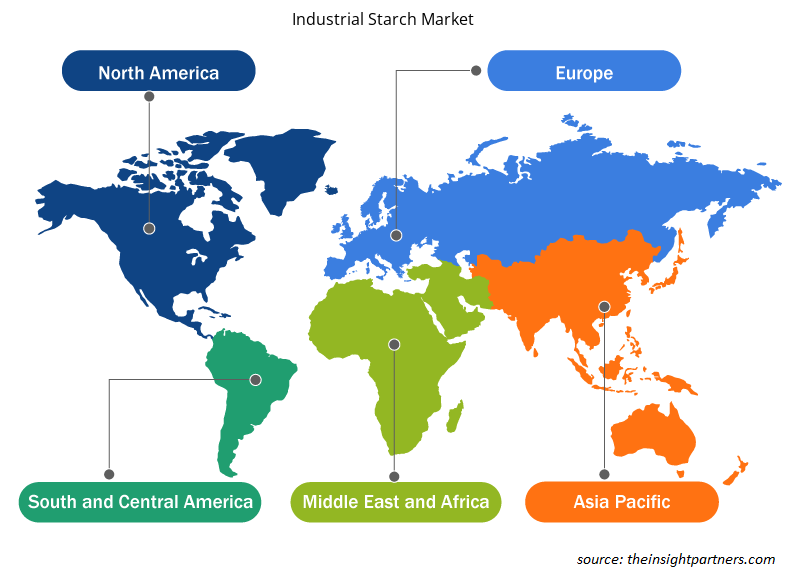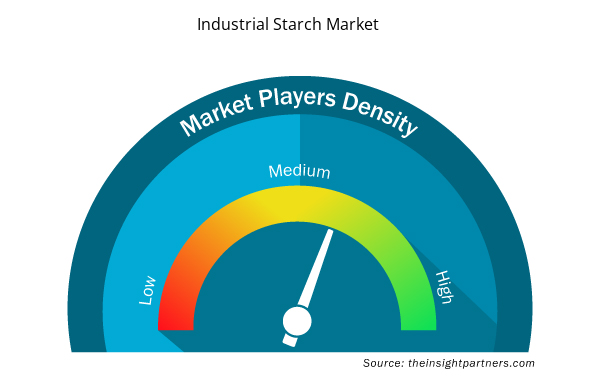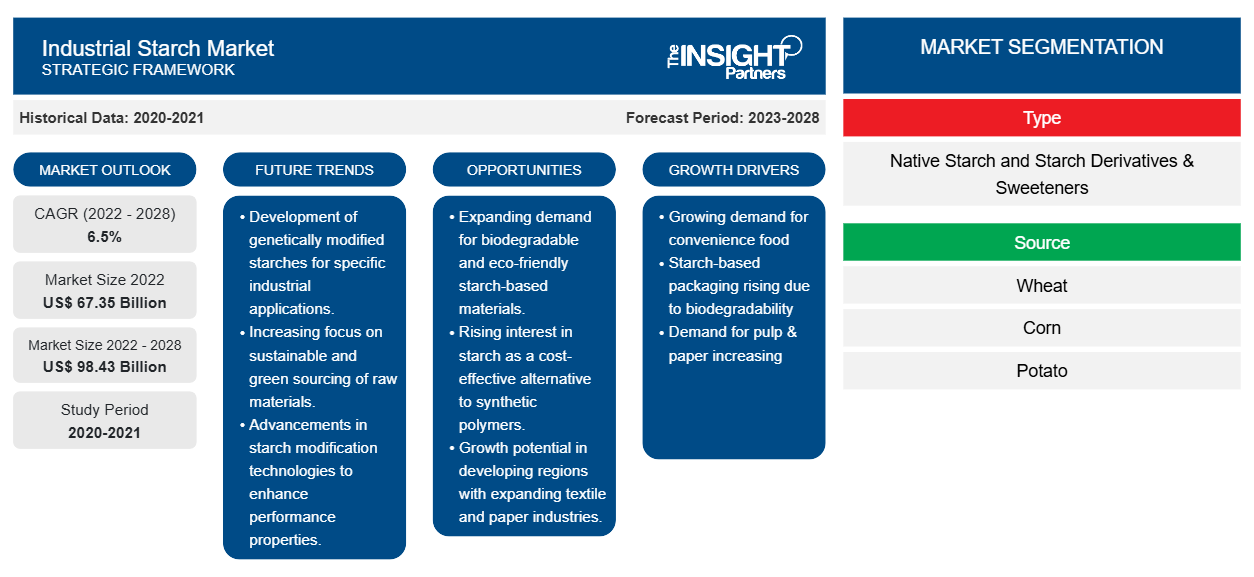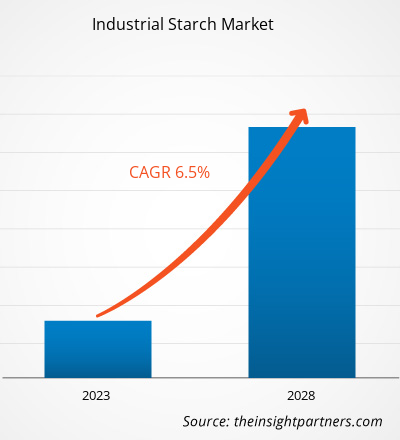[Rapport de recherche] Le marché de l'amidon industriel devrait passer de 67 353,01 millions USD en 2022 à 98 426,74 millions USD en 2028 ; il devrait croître à un TCAC de 6,5 % de 2022 à 2028.
L'amidon est un glucide complexe dérivé du blé, du maïs, de la pomme de terre, du tapioca et du riz. C'est une excellente source d'énergie. L'amidon est un agent épaississant/gélifiant et un stabilisant dans une large gamme d'aliments et de boissons, notamment les produits de boulangerie et de confiserie, les soupes, les sauces, les desserts glacés, les crèmes laitières et les boissons prêtes à boire. La demande de plats cuisinés augmente à l'échelle mondiale en raison du mode de vie frénétique des consommateurs et du revenu par habitant élevé. De plus, les emballages alimentaires à base de papier ont besoin d'un revêtement pour empêcher l'eau ou l'oxygène de pénétrer dans l'emballage et de gâcher les aliments à l'intérieur. Habituellement, ce revêtement protecteur est fabriqué à partir de plastique à base de pétrole. Cependant, les fabricants adoptent des matières premières biosourcées et respectueuses de l'environnement pour le revêtement des emballages alimentaires à base de papier, car ils sont de plus en plus conscients de l'impact négatif du plastique à base de pétrole sur l'environnement. Les caractéristiques des emballages à base d'amidon, telles que la biodégradabilité et le prix abordable, sont en train de stimuler la popularité auprès des fabricants.
Au cours des dernières années, la demande d’amidon dans l’industrie des pâtes et papiers a considérablement augmenté avec l’intensification des opérations dans cette industrie. L’industrie du commerce électronique en plein essor contribue de manière significative à la demande de carton ondulé. De plus, une évolution notable vers des emballages sans plastique pour assurer la durabilité environnementale propulse la demande de matériaux d’emballage durables. Selon une étude menée par Roquette Frères, la consommation d’amidon industriel dans la fabrication de carton ondulé a augmenté de 6 % en 2020 en raison de l’essor significatif du secteur du commerce électronique dans le contexte de la pandémie de COVID-19. Ainsi, la forte demande d’amidon dans l’industrie du papier et du carton soutient le marché de l’amidon industriel
Personnalisez ce rapport en fonction de vos besoins
Vous bénéficierez d'une personnalisation gratuite de n'importe quel rapport, y compris de certaines parties de ce rapport, d'une analyse au niveau des pays, d'un pack de données Excel, ainsi que de superbes offres et réductions pour les start-ups et les universités.
- Obtenez les principales tendances clés du marché de ce rapport.Cet échantillon GRATUIT comprendra une analyse de données, allant des tendances du marché aux estimations et prévisions.
Les fabricants du monde entier profitent de la croissance du secteur du commerce électronique. Partout dans le monde, divers fabricants et canaux de commerce électronique encouragent l'utilisation de matériaux d'emballage durables et respectueux de l'environnement. La croissance du marché de l'amidon industriel devrait s'accélérer grâce à l'adoption croissante de matériaux d'emballage durables par le secteur du commerce électronique. Les sociétés indiennes de commerce électronique Myntra et Flipkart ont adopté des mesures visant à réduire ou à éliminer l'utilisation de plastique à usage unique dans leurs matériaux d'emballage. De plus, les politiques gouvernementales visant à réduire la pollution plastique devraient stimuler la demande d'amidon industriel.benefitting from the growth of the e-commerce industry. Across the globe, various manufacturers and e-commerce channels are promoting the use of sustainable and eco-friendly packaging materials. The industrial starch market growth is expected to boost with this increasing adoption of Myntra and Flipkart have adopted to reduce or eliminate the use of single-use plastic in their packaging materials. Moreover, government policies to reduce plastic pollution is expected to boost the demand for industrial starch.
Informations sur le marché
Le large champ d'application de l'amidon industriel stimule la croissance du marché
Ces dernières années, le domaine d'application des amidons industriels dans diverses industries d'utilisation finale s'est élargi. Il est utilisé comme agent épaississant, gélifiant et liant dans une large gamme d'aliments et de boissons, notamment dans les produits de boulangerie, les soupes et les vinaigrettes, les confiseries, les sauces, les glaces , les boissons aux fruits et les produits laitiers. L'amidon est également utilisé dans des applications non alimentaires telles que la pâte à papier et le papier, les produits pharmaceutiques et les aliments pour animaux. Dans l'industrie pharmaceutique, l'amidon est utilisé comme excipient et liant dans la fabrication de comprimés. De plus, les matériaux à base d'amidon sont une solution parfaite pour les matériaux d'emballage alimentaire biodégradables qui aident à réduire la pollution de l'environnement.excipient and binding agent in tablet making. Moreover, starch-based materials are a perfect solution for biodegradable food packaging materials that help to reduce environmental pollution.
Informations sur les types
En fonction du type, le marché de l'amidon industriel est segmenté en amidon natif et en dérivés d'amidon et édulcorants. En 2021, le segment des dérivés d'amidon et des édulcorants a dominé le marché. La demande croissante d'aliments et de boissons, due à l'augmentation des niveaux de revenu disponible et à l'augmentation de la population mondiale, et l'utilisation de dérivés d'amidon dans les industries alimentaires et des boissons constituent le moteur de croissance le plus important pour le segment des dérivés d'amidon du marché de l'amidon industriel.
Agrana Beteiligungs-AG ; ADM ; Ingredion Incorporated ; Roquette Frères ; Tereos Group ; Cargill, Incorporated ; Tate & Lyle PLC ; Grain Processing Corporation ; Royal Cosun ; et AVEBE figurent parmi les principaux acteurs du marché de l'amidon industriel. Les principaux acteurs adoptent plusieurs stratégies, telles que les fusions et acquisitions et les lancements de produits, pour étendre leur présence géographique et leur base de consommateurs. Beteiligungs-AG; ADM; Ingredion Incorporated; Roquette Frères; Tereos Group; Cargill, Incorporated; Tate & Lyle PLC; Grain Processing Corporation; Royal Cosun; and AVEBE are among the key players operating in the industrial starch market. The leading players adopt several strategies, such as mergers & acquisitions and product launches, to expand their geographic presence and consumer base.
Rapports en vedette
- Tendances progressistes dans le secteur de l'amidon industriel pour aider les acteurs à développer des stratégies efficaces à long terme
- Stratégies de croissance commerciale adoptées par les entreprises pour assurer leur croissance sur les marchés développés et en développement
- Analyse quantitative du marché mondial de l'amidon industriel de 2021 à 2028
- Estimation de la demande en amidon industriel dans diverses industries
- Analyse des cinq forces de Porter pour illustrer l'efficacité des acheteurs et des fournisseurs opérant dans l'industrie de l'amidon industriel
- Développements récents pour comprendre le scénario concurrentiel du marché et la demande d'amidon industriel
- Tendances et perspectives du marché associées aux facteurs régissant la croissance du marché de l'amidon industriel
- Compréhension des stratégies qui sous-tendent l'intérêt commercial en ce qui concerne la croissance du marché, aidant au processus de prise de décision
- Taille du marché de l'amidon industriel à différents nœuds du marché
- Aperçu détaillé et segmentation du marché ainsi que de sa dynamique sectorielle
- Taille du marché de l'amidon industriel dans diverses régions avec des opportunités de croissance prometteuses
Aperçu régional du marché de l'amidon industriel
Les tendances régionales et les facteurs influençant le marché de l’amidon industriel tout au long de la période de prévision ont été expliqués en détail par les analystes d’Insight Partners. Cette section traite également des segments et de la géographie du marché de l’amidon industriel en Amérique du Nord, en Europe, en Asie-Pacifique, au Moyen-Orient et en Afrique, ainsi qu’en Amérique du Sud et en Amérique centrale.

- Obtenez les données régionales spécifiques au marché de l'amidon industriel
Portée du rapport sur le marché de l'amidon industriel
| Attribut de rapport | Détails |
|---|---|
| Taille du marché en 2022 | 67,35 milliards de dollars américains |
| Taille du marché d'ici 2028 | 98,43 milliards de dollars américains |
| Taux de croissance annuel composé mondial (2022-2028) | 6,5% |
| Données historiques | 2020-2021 |
| Période de prévision | 2023-2028 |
| Segments couverts | Par type
|
| Régions et pays couverts | Amérique du Nord
|
| Leaders du marché et profils d'entreprises clés |
|
Densité des acteurs du marché de l'amidon industriel : comprendre son impact sur la dynamique des entreprises
Le marché de l'amidon industriel connaît une croissance rapide, tirée par la demande croissante des utilisateurs finaux en raison de facteurs tels que l'évolution des préférences des consommateurs, les avancées technologiques et une plus grande sensibilisation aux avantages du produit. À mesure que la demande augmente, les entreprises élargissent leurs offres, innovent pour répondre aux besoins des consommateurs et capitalisent sur les tendances émergentes, ce qui alimente davantage la croissance du marché.
La densité des acteurs du marché fait référence à la répartition des entreprises ou des sociétés opérant sur un marché ou un secteur particulier. Elle indique le nombre de concurrents (acteurs du marché) présents sur un marché donné par rapport à sa taille ou à sa valeur marchande totale.
Les principales entreprises opérant sur le marché de l'amidon industriel sont :
- Société anonyme d'AGRANA
- SMA
- Ingredion Incorporated
- Roquette Frères
- Groupe Tereos
Avis de non-responsabilité : les sociétés répertoriées ci-dessus ne sont pas classées dans un ordre particulier.

- Obtenez un aperçu des principaux acteurs du marché de l'amidon industriel
L'analyse du marché de l'amidon industriel jusqu'en 2028 est une étude spécialisée et approfondie de l'industrie des produits chimiques et des matériaux, axée sur l'analyse des tendances du marché. Le rapport vise à fournir un aperçu du marché avec une segmentation détaillée. Le marché de l'amidon industriel est segmenté en fonction du type, de la source, de l'application et de la géographie. En fonction du type, le marché de l'amidon industriel est segmenté en amidon natif et dérivés d'amidon et édulcorants. En fonction de la source, le marché est segmenté en blé, maïs, pomme de terre, manioc et autres. En fonction de l'application, le marché est segmenté en aliments et boissons, pâtes et papiers, aliments pour animaux, produits pharmaceutiques et autres. En fonction de la géographie, le est segmenté en cinq régions principales : l'Amérique du Nord, l'Europe, l'Asie-Pacifique, le Moyen-Orient et l'Afrique, et l'Amérique du Sud et l'Amérique centrale. En 2021, l'Asie-Pacifique a dominé le marché de l'amidon industriel.
- Analyse historique (2 ans), année de base, prévision (7 ans) avec TCAC
- Analyse PEST et SWO
- Taille du marché Valeur / Volume - Mondial, Régional, Pays
- Industrie et paysage concurrentiel
- Ensemble de données Excel



Report Coverage
Revenue forecast, Company Analysis, Industry landscape, Growth factors, and Trends

Segment Covered
This text is related
to segments covered.

Regional Scope
North America, Europe, Asia Pacific, Middle East & Africa, South & Central America

Country Scope
This text is related
to country scope.
Questions fréquemment posées
Growth in the global food and beverage industry and an increase in demand from the packaging industry are drivers of the industrial starch market. The growing population around the world is increasing the demand for the food and beverages industrial starch market. And the significant growth of e-commerce and increasing adoption of eco-friendly packaging material is expected to propel the demand for industrial starch.
The major players operating in the global industrial starch market is AGRANA Beteiligungs-AG; ADM; Ingredion Incorporated.; Roquette Frères; Tereos Group; Cargill, Incorporated Tate & Lyle PLC; Grain Processing Corporation; Royal Cosun; AVEBE.
In 2021, North America accounted for the highest growth of the global industrial starch market. Starch is used as a thickening/gelling agent and stabilizer in a wide range of food and beverages, including bakery and confectionery products, soups, sauces, frozen desserts, dairy creamers, and ready-to-drink beverages. The rising demand for convenience food owing to the hectic lifestyle and high per-capita income of consumers is driving the demand for starch in the food & beverages industry. Veganism and clean-label trends are surging rapidly across the world.
Product innovation in industrial starches is a recent trend in the global industrial starch market. There is a strong demand for products with organic, clean-label, and plant-based ingredients in Europe owing to rising health and wellness concerns. This clean-label product provides instant viscosity, thereby enabling optimal control of rheological behavior in cake mixes, sauces, or other semiliquid formulations. It can also be used to prepare high-quality savory products, pastries, and fruit-based fillings to provide a premium look and texture.
Based on the application pulp and paper segment is leading the market in 2021. As there is a high demand for starch from the papermaking industry in the region due to the rising demand for paper products from the packaging and transportation industries. The booming e-commerce industry in the region is also generating demand for corrugated paper and paperboards, thereby contributing to the industrial starch market progress
Based on the segment type, starch derivatives and sweeteners were the fastest-growing segment in 2021. Starch derivatives and sweeteners are obtained from the further processing of native starch. Usually, native starch is converted into glucose syrup, which is processed to obtain maltodextrins, isoglucose, polyols, and dextrose
Trends and growth analysis reports related to Food and Beverages : READ MORE..
The List of Companies - Industrial Starch Market
- AGRANA Beteiligungs-AG
- ADM
- Ingredion Incorporated
- Roquette Frères
- Tereos Group
- Cargill, Incorporated.
- Tate & Lyle PLC
- Grain Processing Corporation
- Royal Cosun
- AVEBE
The Insight Partners performs research in 4 major stages: Data Collection & Secondary Research, Primary Research, Data Analysis and Data Triangulation & Final Review.
- Data Collection and Secondary Research:
As a market research and consulting firm operating from a decade, we have published and advised several client across the globe. First step for any study will start with an assessment of currently available data and insights from existing reports. Further, historical and current market information is collected from Investor Presentations, Annual Reports, SEC Filings, etc., and other information related to company’s performance and market positioning are gathered from Paid Databases (Factiva, Hoovers, and Reuters) and various other publications available in public domain.
Several associations trade associates, technical forums, institutes, societies and organization are accessed to gain technical as well as market related insights through their publications such as research papers, blogs and press releases related to the studies are referred to get cues about the market. Further, white papers, journals, magazines, and other news articles published in last 3 years are scrutinized and analyzed to understand the current market trends.
- Primary Research:
The primarily interview analysis comprise of data obtained from industry participants interview and answers to survey questions gathered by in-house primary team.
For primary research, interviews are conducted with industry experts/CEOs/Marketing Managers/VPs/Subject Matter Experts from both demand and supply side to get a 360-degree view of the market. The primary team conducts several interviews based on the complexity of the markets to understand the various market trends and dynamics which makes research more credible and precise.
A typical research interview fulfils the following functions:
- Provides first-hand information on the market size, market trends, growth trends, competitive landscape, and outlook
- Validates and strengthens in-house secondary research findings
- Develops the analysis team’s expertise and market understanding
Primary research involves email interactions and telephone interviews for each market, category, segment, and sub-segment across geographies. The participants who typically take part in such a process include, but are not limited to:
- Industry participants: VPs, business development managers, market intelligence managers and national sales managers
- Outside experts: Valuation experts, research analysts and key opinion leaders specializing in the electronics and semiconductor industry.
Below is the breakup of our primary respondents by company, designation, and region:

Once we receive the confirmation from primary research sources or primary respondents, we finalize the base year market estimation and forecast the data as per the macroeconomic and microeconomic factors assessed during data collection.
- Data Analysis:
Once data is validated through both secondary as well as primary respondents, we finalize the market estimations by hypothesis formulation and factor analysis at regional and country level.
- Macro-Economic Factor Analysis:
We analyse macroeconomic indicators such the gross domestic product (GDP), increase in the demand for goods and services across industries, technological advancement, regional economic growth, governmental policies, the influence of COVID-19, PEST analysis, and other aspects. This analysis aids in setting benchmarks for various nations/regions and approximating market splits. Additionally, the general trend of the aforementioned components aid in determining the market's development possibilities.
- Country Level Data:
Various factors that are especially aligned to the country are taken into account to determine the market size for a certain area and country, including the presence of vendors, such as headquarters and offices, the country's GDP, demand patterns, and industry growth. To comprehend the market dynamics for the nation, a number of growth variables, inhibitors, application areas, and current market trends are researched. The aforementioned elements aid in determining the country's overall market's growth potential.
- Company Profile:
The “Table of Contents” is formulated by listing and analyzing more than 25 - 30 companies operating in the market ecosystem across geographies. However, we profile only 10 companies as a standard practice in our syndicate reports. These 10 companies comprise leading, emerging, and regional players. Nonetheless, our analysis is not restricted to the 10 listed companies, we also analyze other companies present in the market to develop a holistic view and understand the prevailing trends. The “Company Profiles” section in the report covers key facts, business description, products & services, financial information, SWOT analysis, and key developments. The financial information presented is extracted from the annual reports and official documents of the publicly listed companies. Upon collecting the information for the sections of respective companies, we verify them via various primary sources and then compile the data in respective company profiles. The company level information helps us in deriving the base number as well as in forecasting the market size.
- Developing Base Number:
Aggregation of sales statistics (2020-2022) and macro-economic factor, and other secondary and primary research insights are utilized to arrive at base number and related market shares for 2022. The data gaps are identified in this step and relevant market data is analyzed, collected from paid primary interviews or databases. On finalizing the base year market size, forecasts are developed on the basis of macro-economic, industry and market growth factors and company level analysis.
- Data Triangulation and Final Review:
The market findings and base year market size calculations are validated from supply as well as demand side. Demand side validations are based on macro-economic factor analysis and benchmarks for respective regions and countries. In case of supply side validations, revenues of major companies are estimated (in case not available) based on industry benchmark, approximate number of employees, product portfolio, and primary interviews revenues are gathered. Further revenue from target product/service segment is assessed to avoid overshooting of market statistics. In case of heavy deviations between supply and demand side values, all thes steps are repeated to achieve synchronization.
We follow an iterative model, wherein we share our research findings with Subject Matter Experts (SME’s) and Key Opinion Leaders (KOLs) until consensus view of the market is not formulated – this model negates any drastic deviation in the opinions of experts. Only validated and universally acceptable research findings are quoted in our reports.
We have important check points that we use to validate our research findings – which we call – data triangulation, where we validate the information, we generate from secondary sources with primary interviews and then we re-validate with our internal data bases and Subject matter experts. This comprehensive model enables us to deliver high quality, reliable data in shortest possible time.


 Obtenez un échantillon gratuit pour ce rapport
Obtenez un échantillon gratuit pour ce rapport